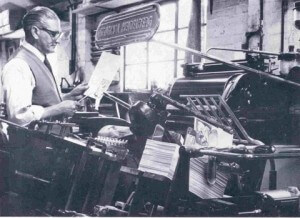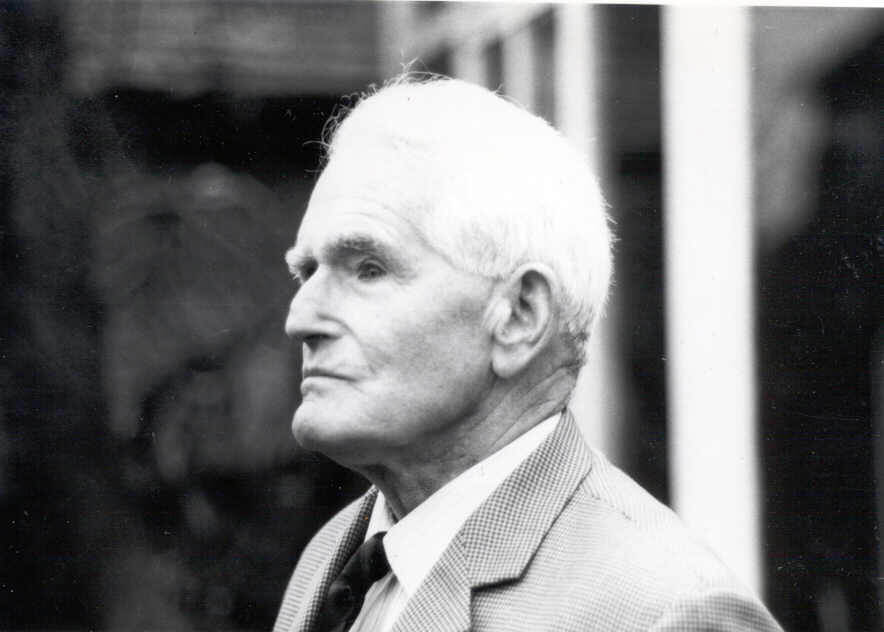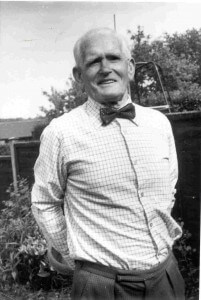This obituary has been copied from the April 1981 Amersham Society News written by Frank Peers
One of the grand old gentlemen of Amersham died peacefully in January. He earned this title, although he had not lived in the town for many years, by all the work he had done to record his own recollections and his researches into the history of the town.

A brother of Stanley Mason, the printer, Reg was born at The Eagle in the High Street in 1895. He attended St Mary’s School (Back Lane School as it was known then) and came under the ministrations of Stumpy Garton who was the headmaster there for 36 years. [In a note written by Reg Mason, he described him as: “William Garton, headmaster, choirmaster, organst and football referee of some fame, was in charge of Back Lane Schools.”] On leaving school, he worked first at Weller’s Brewery and later for a solicitor, Mr Rushforth, in the High Street. It was here, no doubt, that he gained an interest in and an understanding of old documents.

Between the wars he worked in London and it was during this period that he started to investigate the history of Amersham, spending many of his lunch breaks in the Public Records Office searching for and recording references to the town. It was thus that he was able to purchase a spare copy of the 1836 Tithe Map of the area, a reproduction of which can be seen in the Amersham Museum.
Throughout this period he was preparing notes on his findings and on his early recollections of the town which, in due course, he presented to the County Library at Aylesbury. Copies of many of these were available for reference at Amersham Library. Much of the information in the Museum’s ‘Walk Around the Old Town’ leaflet was derived from his notes and from conversations with him. He surely deserved the accolade he liked to give himself as ‘the first graduate of Back Lane School’. He will be sadly missed by all who knew him.
——————————————————————————-
Listen to Reg Mason talking about Amersham:
R1_0030 Reg reciting a WWI poem Amersham in Flanders by Paul England who lived in Market Square.
R1_0034 Childhood diseases
R1_0034 Horse racing in Amersham and rivalry between Amersham and Chesham
and more recordings about Back Lane School, Pondwicks and cricket on Barn Meadow.
——————————————————————————-
Reg Mason’s account of Town Farm when he was a boy shows his love of the town’s history and below is an extract from his book “Amersham 1895-1970 Some Reflections” about The Eagle
Let me take my own parent’s house as an example; they kept “The Eagle” for forty years. There was stabling for two horses beside the river, two toilets, and the large washhouse between. The washhouse in particular is worth describing. It contained a large “back-breaker” mangle, weighted with about 20lb. lumps of iron at each end for wringing; no adjustment necessary for the strong. A pump, complete with lead traditional spout over a hardstone sink with run-away to the river . All knives were sharpened on the sink especially on pig killing days. The water heating system was by a “copper”, with fire below and well chimneyed for good draught; wooden top, no tap, simply bale out water by ‘dipper’ into the largest bath in Christendom . And afterwards, bale out water into sink for the Misbourne. The floor was of brick and there were many beautifully made ‘washing tubs, Dollies, etc., all clean and white and, of course, several typical clothes baskets with handles at the top of each end.
There was a large pig-stye, with outside brick walled run which had no occupants in my day, but there had been if I remember rightly from my secret seclusion there whilst trying my first cigarette; a bit dangerous too for the straw bedding was still there. I remember, too, crawling out a bit dizzy and no doubt also somewhat green-looking and sought the more salubrious ozone of the river .
A lot of chickens were kept, and always chicks were reared when sitting hens were ready for that purpose. They were well fed with maize and corn fetched from the mill in large quantities, or from my uncle who grew his own wheat etc. They had proper roosting perches, and well-strawed nests in which to lay the eggs, complete with encouraging china dummy ones.
Cider was manufactured in due season and the presses and other machinery were kept in an open shed. There was no such thing as a dustbin. Everything unwanted went into the ‘ashpit’, which was not a pit at all but a ten foot high building with a sloping roof down to about four feet with a large ‘in’ and a smaller sliding-doored ‘out’. This so-called pit fell out of use with fewer animals and birds around and my younger brother made good use of it by putting some rabbit wire over the ‘in’ end so that he would keep a mixed assortment of pigeons, such as tumblers, poulters, fan-tails and the like. Our opinions differed widely on the merits of this collection. We were both touchy tempered kids. He grabbed my 3s.6d “Daisy” airgun which was loaded (muzzle end) with a BB shot, quickly placed it against my hind quarters and pulled the trigger. Then he rudely threw it to the ground and ran. I must have come down to earth with commendable presence of mind for I quickly loaded and hit him in the same place before he reached cover. Boys are sometimes stupid creatures but they nevertheless have their codes of honour it seems. We had often heard the text about “turn to him the other cheek” and probably this was another interpretation of it.
In front of the washhouse door was a very substantial telegraph pole carrying about 40 wires; now wires are defunct and all is removed. There was also a smaller pole which supported two pigeon boxes, each of about eight nesting boxes. Pigeons were a delicacy then, particularly young “squeakers” for which the butcher would willingly pay 15s.4d a pair. Today they are almost unwanted; plucking and preparation is probably the reason.
Then there was the long shed opening on to the High Street which was thought once to have been a skittle alley. This was the coal store and wood store. The latter was cheap and there seemed always plenty of handy lengths of timber which were unsuitable for turning into chair legs for High Wycombe factories. It was dry and splittable.
The Tap Room, as distinct from the more aristocratically named Smoke Room, was a very cosy place in cold weather as it has a huge open fireplace. Some folk liked to warm their beer in which case there was a “warmer” hanging nearby. This was a locally made dunce-hat shaped affair with a handle at the wide end, all of tin. The liquid was poured into this and the pointed end thrust well down into the embers where it remained securely upright until a rule-of-the-thumb estimate deemed the right temperature had been reached. But not for me, thank you, for I could never drink beer with the slightest degree of pleasure. Nevertheless there was always a joy in seeing a pint well sunk when deserved by hard manual labour. The game of “Ring the Bull” has always been there. The four inch hole in the substantial seat under the window, with drawer beneath, was used for pitch-penny. Naturally, the usual beautifully polished shove-halfpenny board, dominoes, and the other well known games were played, but never cards.
These were the days of do-it-yourself amusements when most people sang rural songs, often accompanied by concertina. Bone “Clappers” (about four inches long, one inch wide, and about a quarter of an inch thick) were popular still with everyone, even children. They were played by rattling them by being placed one on each side of a finger. But you will not make much of a job of it if you try. The noise was rather like that made by tap-dancers.
The Smoke Room needs little description because of its greater respectability and its chief use in the main was for the regular weekly meetings of the Slate Club which might be called a parochial welfare state affair of mini proportions in every respect. At times of adversity subscribers to this who required monetary benefit had opted out of the necessity of applying for parish relief and the hated slur upon the character of being called a pauper. It was certainly a commendable form of self-help, and all the officials were appointed by the members themselves who were supplied with a printed rule book. It was an annual affair and the year finished up with a dinner, which was a most elaborate event held just before Xmas when the balance of the funds remaining in the kitty were shared out evenly. Hard working people could really eat in those days and there was no need for a menu for they were not very fussy and relished as many things as could possibly be heaped on a plate. Grace was always said at the onset and the plates had a familiar text on the rim which just simply said “Think and Thank”. And not a bad motto either! It was a busy day for those preparing the meal and the baker’s oven next door was indispensable. The cooking pots for the brussel sprouts, potatoes etc. were made of solid iron, large and with handles on each side of the top. Well fire-blackened on the outside of course. The top of the gas stove could only accommodate two of these huge utensils, and then there was a good deal of overlap.
The cellar was so named because of the contents and had nothing to do with elevation as might be supposed. It held four barrels (36 gallons each) on one side and two on the other. These were mounted on to solid and substantial wooden frames, from the ends of which they were rolled up as they were sloped for the purpose. Brass taps were always used and vent pegs with the necessary hammer (wooden mallet really) were always kept at hand for when a barrel required “tapping”, as it was called. Please do not attempt to do that yourself if you are still wearing L plates and not wearing wellingtons; take advice first for there are two ways of doing it, the right and the wrong, and firemen hate pumping beer out of houses into drains.
There was nothing particular about the kitchen; just chairs to seat eight, square table and plenty of wide shelves for large dishes and utensils. Ordinary sink with waste pipe leading into bucket below. Washing up water saved as swill for uncle’s pigs and tipped into pig bin outside with everything else; no doubt there was a rewarding rake-off later on, possibly chitterlings or pig’s head for brawn. Or it might have been a basin of snow-white lard from the rendering down of fat oddments. Favourite meal: “Toad in the Hole”.


